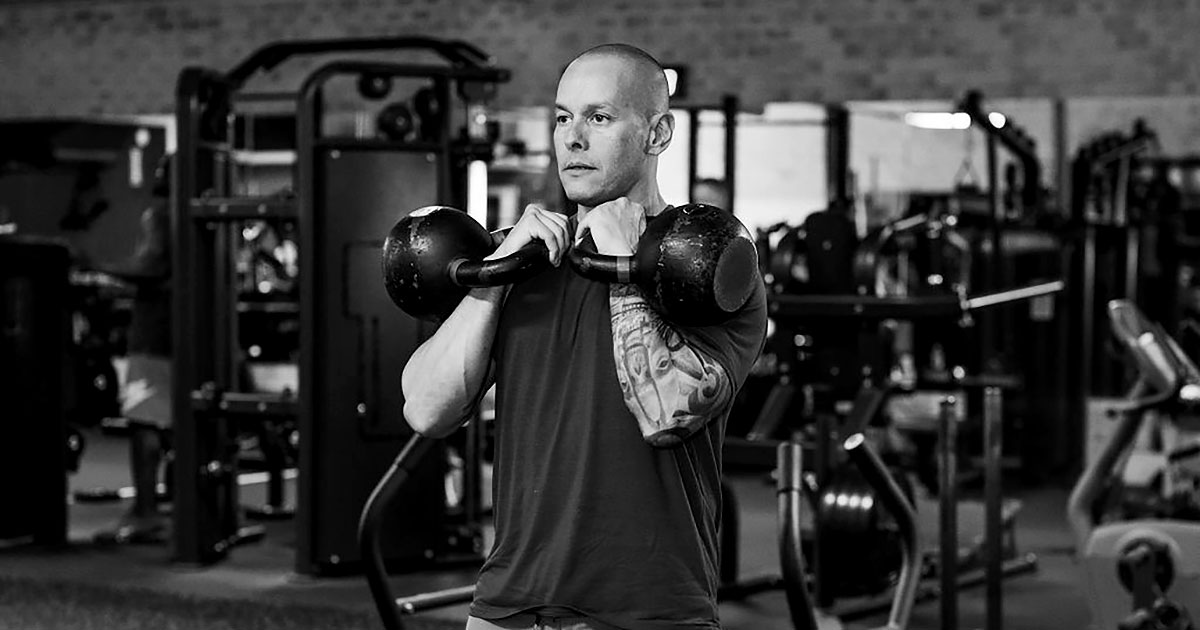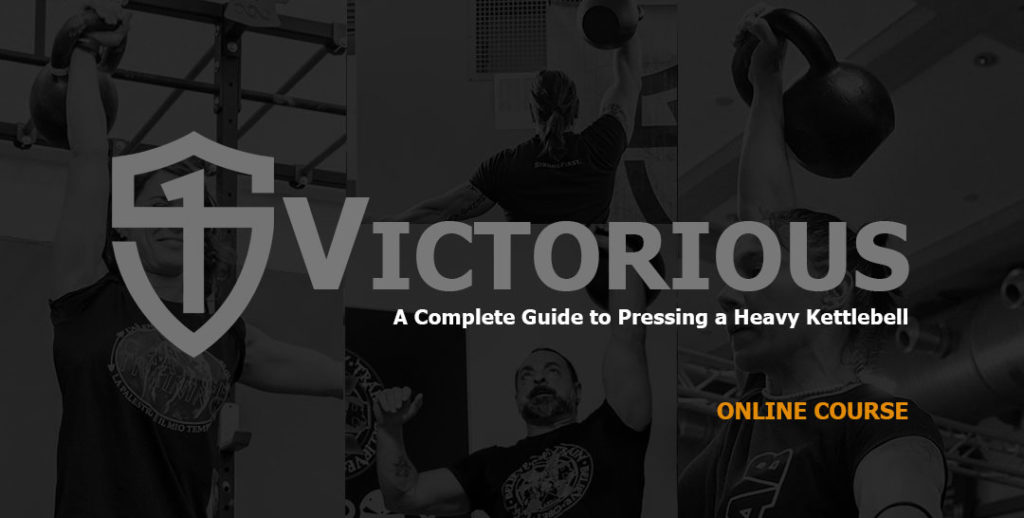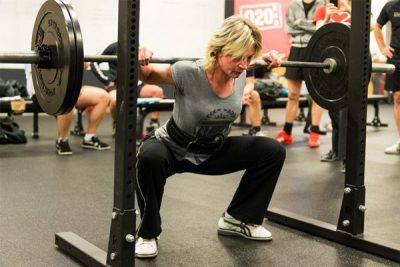
The year is 2006, and one of my personal training students was inquiring about my next training plan.
Student: So, what’s your next routine, Os?
Me: I’m doing a program called Enter the Kettlebell (ETK).
Student: What is that?
Me: I’ll be doing kettlebell clean & press three times a week, snatches once a week, and swings twice a week.
Student: Wait. So, you’re only doing three exercises? That’s it?
Me: Yeah, that’s it.
Even then, being a hard style rookie, I knew my student was painfully oversimplifying what I was about to embark on and the profound impact this protocol would come to have on me as a fitness professional and human being.
This is the account of how my love for ETK started, how my practice evolved over three years, and how its end marked the beginning of a paradigm shift that I proudly continue to nurture today.
My Introduction to the Kettlebell
So, where can I get my hands on one of these things? I asked Sarah Lurie, founder of Iron Core in Las Jolla, CA, one fateful morning after her Start Me Up workshop.
Dragon Door. She replied.
I had just spent an hour being introduced to the subtleties of hard style doctrine. Things like bracing, diaphragmatic breathing, packing shoulders, static stomps, hands as hooks, projecting with the hips, deceleration, and redirection. My head was spinning, but my ears were wide open, and my soul was happy. I had not been this excited about learning something new in a long time. It was clear that I had found gold, and I needed to learn this technique along with all of its methods. First, for myself, and second, for my students. The full-body movements made everyone around the room look athletic, despite our various skill levels. The way Sarah had brought a group of six newbies to safely perform the movements within an hour of an introductory workshop was masterful, and it was clear that a particular methodology was at work. The use of imagery to reinforce concepts reminded me of dance and martial arts classes. The use of drills to give the students an opportunity to feel what the movement would eventually become was so on point one could not help but smile. I left the workshop energized and eager to dive into this newfound interest.
My First Kettlebell
The ETK book arrived before the kettlebell, which worked out well because it allowed me to get acquainted with what I thought I knew—all the techniques I learned at the workshop. I was especially confident about the get-up and the swing, as these were the main movements we had learned.
In ETK, you are directed to perform the break-in plan, which consists of studying the book, watching the DVD, and performing a minimum of three “practices” each week for thirty minutes. During these thirty minutes, you are to perform the warm-up drills, remedial moves, swings, and get-ups. As my student said, that’s it.
Now we know better and an entire protocol involving only swings and get-ups has emerged, laid out in Pavel’s best-selling book Kettlebell Simple & Sinister. I could have stopped at the break-in plan and been just fine, but the prospect of doing 75 reps per side of clean & press on Saturdays, just for fun, was too enticing to ignore.
My kettlebell arrived on a Tuesday. I remember because I had dance rehearsal from 7:00pm to 10:00pm every Tuesday and Thursday, and by the time I got home it was too late to do anything substantial. However, I still picked it up and tried several ugly movements with the darn thing—no doubt without skill or grace but with undeniable enjoyment. I told my roommate all the treasures that awaited me with this strange-looking utensil—the strength, the mobility, the stability, the conditioning, and all with one tool.
Greg was not a training guy, but he was happy that I had found the cure to, apparently, all my woes. He stood up and tried to pick it up haphazardly, only to realize 20kg in kettlebell form felt much heavier than expected. As it has been said, the weight is alive. He looked at me in disbelief and said, “Wait, what are you doing with this thing?”
I proceeded to explain the entire process from the break-in plan to the subsequent protocol. Ladders? Dice? What’s a snatch? Is that it? All while playing Madden PlayStation 2 and stressing over my 6:00am personal training session. Life was grand.
My first practice did not go well. Remember all those things I had learned at the workshop that I thought I knew? Well, as it turns out, I didn’t. It wasn’t even close. It was like someone put me in a different body. There is a big difference between being led in a group environment by a skilled instructor and trying to remember the movements a couple of weeks later at your local park with the sun on your face. However uncomfortable this moment of uncertainty was, it was the moment when everything changed, and I began to transform into a hard style practitioner. I could now apply my discipline and movement skills to strength training because this paradigm encouraged such a thing. I cannot tell you with certainty how long I stayed in the break-in plan. But it was at least a few months before I felt competent enough in my swings and get-ups to transition to the full program. But at last, Enter the Kettlebell.
Enter the Kettlebell
The first full week of ETK was unremarkable. I knew the snatches would be clunky but that ladders of (1,2,3) x 5 would be manageable. It wasn’t the weight, the 20kg kettlebell was adequate for my strength and size, but the technique I was concerned with. I had been around the block enough times to know that learning proper technique was paramount if I wanted to establish a long and healthy relationship with the kettlebell. Being conservative in training has always paid off for me. A slow and methodical approach in other training modalities such as martial arts, boxing, wrestling, dance, and conventional training had always worked. Hard style training was no different. If anything, it encouraged it.
After a few weeks, I bumped the ladders up to four rungs and eventually five. The first Saturday I went all the way to 75 reps per side was exciting, but I was fried the next day. My hard style technique was still developing, and I am sure there were issues, but the snatch was safe to perform regularly as I slowly built my skill. This is important because it is an example of hard style doctrine in action. We approach our work as skill practice and prioritize safety over intensity and numbers.
Over months of working with the 20kg kettlebell, I discovered the joys of hard style training. On the way to finding the perfect groove for a given movement, based on the criteria that constitute good form, we learn a lot about our bodies. If we are tuned into what we are doing and actively trying to learn, we adapt and overcome. If we stubbornly continue hammering away at less-than-stellar form, we discover how mortal we are. Either way, the solution is always Tiger Balm.
The simplicity of ETK allowed me to focus on learning the clean, snatch, press, and swing unencumbered by injuries with only minor bumps and bruises to account for—easily addressed with proper rest, nutrition, and the profuse use of Tiger Balm. Tiger Balm is like duct tape for the body. It can fix anything. At some point, I must have been doing something very wrong with my lockouts because my knees were constantly aching. Luckily, this didn’t last long. I was probably not fully extending and locking my knees at the top of ballistic movements. While all of this was concerning and annoying, nothing was as problematic as my hands.
As my strength and conditioning improved, my lack of a hand care routine showed, and my callouses were so rough my girlfriend asked me to scratch her back with them. My hands turned into extra rough loofahs. Through experience, I learned to use a pumice stone on my hands and that Corn Husker lotion is a hard-styler’s best friend. Between Tiger Balm and Corn Huskers, I had my personal, full-time athletic trainer team to help me stay in the game. During the first year of doing ETK, I was a ripped 150lb, with some people describing my physique as an anatomical chart. Being a dancer at 150lb, I was relatively strong for my size and could pull double my bodyweight in a deadlift without training specifically for it. I was full of energy from ETK training even with dance, school, and working 20 to 24 hours a week as a personal trainer. I had exceptional endurance and flexibility for contemporary dance, just by focusing on four movements inside four hours of strength training every week. Not bad for a program everyone thought wouldn’t be enough.
Adding in Pullups
My first true progression in ETK came around the one-year mark. It was a simple one. I bought myself a 24kg kettlebell. I had grooved myself to the gills with the 20kg kettlebell so making the jump to 24kg felt as natural as breathing. I was on a roll like I had never been before. It was somewhere in that second year I made the second adjustment—bring on the pullups.
I started the pullups as prescribed in the book on a one-to-one ratio. Mondays I was popping off 30 pullups, Wednesdays 50, and on Saturdays, I was cranking out 75 perfect reps. Initially, I kept doing clean & press, but it became evident that my hands were not happy about this, so I took out the clean on every rep. Instead, I cleaned the kettlebell once and then performed multiple presses.
Adding pullups made me look denser and better conditioned, while adding noticeable muscle to my upper body. In the book, we are advised to stay with cleaning on every rep until our technique is proficient, and after a year, my cleans were tight. One of the challenges of early ETK development is the long Saturday session. Taking the cleans out and injecting pullups into the mix was a solid choice. Occasionally, I would do clean & press for one or two sessions to keep my technique and spirit sharp.

Pullup ladders of (1,2,3,4,5) x 5 became easy after a while, so I doubled it to (2,4,6,8,10). To be clear, on Mondays, I would do three rungs, (2,4,6) x 5, followed by four rungs, (2,4,6,8) x 5 on Wednesdays. This led into the hard style party that is Saturdays—five rungs. Cue the Wu-Tang track. I did (3,6,9,12,15) a handful of times, but it was absolute hell to complete Saturdays. I took Rif’s advice and stepped off that hill before I got kicked off.

Enter Double Kettlebell Work
From here, I knew I was ready to make another adjustment, leading to the double period. Double kettlebell work is deceivingly complex. One might think it’s just one more kettlebell, how hard could it be? Well, it’s a little like MMA math; it just doesn’t add up. Double kettlebell work equals three times the effort and four times the focus.
In Iron Cardio, StrongFirst Director of Education, Brett Jones talks about the energetics of the first rep. I wish I had read that before going double. One thing that immediately stood out was how much power I got from the double work. My dance teacher used to say that I jumped like a deer, and I did. Once again, I got a little denser and had gained a lean ten pounds of muscle, which put me at around 160lb. Another weird side effect or “what the heck effect,” as it is known in hard style training, was that my hand balancing felt easier. The kettlebell press groove with the overhead lock-out emphasis transferred to the handstand like it was made for it. Also, my stronger back and smarter midsection helped me achieve the beautiful pike press-up into a handstand. It was also around this time that I started consistently doing free-standing handstand pushups. These things were not part of my regime but were cool tricks to practice in between dances at rehearsal. What can I say, I find joy in weird things and places.
Once my body adjusted to the double kettlebell work, I made a glorious return to (1,2,3,4,5) x5 ladders for pullups; only this time, I had 24kg attached to my waist. Well, sometimes it hung from my foot. This took some time to adjust to, but it helped me do 26 pullups at the 2008 Tactical Strength Challenge, hosted by legendary coaches Franz and StrongFirst Certified Senior Instructor Yoana Teran at their iconic kettlebell studio, Revolution Fitness, in La Jolla, CA. I came in at 155lb for this event and pulled a cool 355lb deadlift with minimal training. Put that together with 111 snatches, and my ROI was more than generous. Herein lies the beauty of this compelling and elegant program. Freaky gains with one weight and four moves. No calculations, equipment setup, or changing things up every week. Just pure performance enhancements and enviable aesthetics to complete the hard style look.


TSC 2008, Revolution Fitness, La Jolla, CA
I briefly did ETK with 28kg towards the end of the three-year run. Everything worked except the snatches. I just never got adjusted to the 28kg kettlebell in the format required by the program. I have revisited this program many times since, and I am always impressed by how effective it continues to be for me. If I had to choose one fitness program for the rest of my life, it would be ETK. It is the most elegant and complete program I’ve ever done. If you have never tried it, you should. If you do, be sure to give it enough time to experience its beauty and receive its gifts. Or you can be all evidence-based and frozen yogurt.
Final Thoughts
So how was this possible? How could I do one program for three years and continue making progress? I followed the StrongFirst principles. I may not have known it at the time, but I was. Continuity of training and waving the load were the main variables I changed to keep making gains. My ballistics ranged from 2 to 12 minutes between two movements and at different rates of perceived exertion (RPE). The presses saw two different size kettlebells (20kg and 24kg)—sometimes single and others double. Sometimes there were pullups, sometimes there weren’t. When you consider all these small variances, it’s easy to see not only why it worked, but why it worked magnificently. I was also dancing ten-plus hours a week between rehearsals, classes, and performances. I was greasing the groove on various bodyweight skills, which would be helpful over ten years later when I attended the SFB, with the StrongFirst Certified Master Instructor Karen Smith. Another factor that helped me navigate these seas and stay injury-free was being reasonable in my training. If I had a performance on Friday, I would do Monday’s light training session and skip Wednesday and Friday, which made me extra peppy for the dancing. If I traveled with the dance company, I did one-arm pushups and pistols while on the road. If I found a pullup bar, I would do those too. But by most practical standards, I was doing ETK for three years.

Team Cheatham, San Jose, CA 2008
In 2008 I attended my first kettlebell certification, the RKC, at the home of the Spartans, San Jose State University in California. It was the first time the event had been held outside of Minnesota, and it was a who’s who of hard style legends. Everywhere I looked, I saw strong and charismatic leaders. My Team Leader was Sarah Cheatham, and she was as inspiring as she was formidable—flawless technique, crazy strength, nasty skills, and an equally impressive teaching acumen. I had found my leader and my clan. It was at that moment that I decided I was willing to put in the requisite work to be like them—to have equal skill in doing and teaching, and to be both firm and compassionate. While I didn’t know this then, I was learning to embody the values that would eventually become the School of Strength, StrongFirst, and it all started with ETK.









